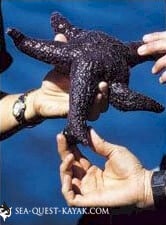Join a Kayak Quest for Whales Today!
I wanted to thank you for an excellent sea kayaking trip. My father and I enjoyed your friendly guides and seeing the killer whales, porpoises, and other creatures at home in the wild. Happy summer. I’m sure I’ll see you again!
Lisa Larrabee, Sacramento, CA
 Arnold, D. 1986. Tides and Currents. Fernhurst Books.
Arnold, D. 1986. Tides and Currents. Fernhurst Books.
Bascom, W. 1964. Waves and Beaches. Anchor.
Brower, K. 1973. The Starship and the Canoe. (Fascinating account of George Dyson’s epic kayaking journeys in the Pacific Northwest. Like a great adventure novel, it has inspired more people to get into sea kayaking than any other book.)
Dowd, J. 1988. Sea Kayaking: A Long Distance Touring Manual. 3rd edition. (Best guide to kayak cruising – slanted towards major expedition travel.)
Dyson, G. Baidarka. 1986. (An historical, cultural, and artistic view of the evolution of sea kayaks. Awesome. Author is subject of Brower’s book listed above!)
Joel Rogers. 1992. The Hidden Coast. Alaska Northwest Books. (Coffee table book by a photographer/writer who has spent many years kayaking all over the west coast.)
Tawrell, P. 2006. Campingand Wilderness Survival. Campingbook.com. (Encyclopedic!)
Adams, Evelyn. 1995. San Juan Islands Wildlife: A Handbook for Exploring Nature. The Mountaineers Books, Seattle, Wash. (A joyful personal tour to the San Juan’s natural treasures. Profiles of many of the regions leading natural history authorities and personalities, including one of our founder Mark Lewis.)
Atkinson, S.R., and F.S.Sharpe. 1985. Wild Plants of the San Juan Islands. The Mountaineers Books, Seattle, Wash. (Co-authored by a staff member.)
Lewis, M.G., and F.S.Sharpe. 1987. Birding in the San Juan Islands. The Mountaineers Books, Seattle, Wash. (Written by our staff members; not a field identification guide – intended to help locate birds and understand more than just their names.)
Mueller, M. 1988. San Juan Islands: Afoot and Afloat. 2nd edition. The Mountaineers Books, Seattle, Wash.
Suttles, W. 1987. Coast Salish Essays. Talonbooks, Burnaby, B.C. One of the few works on the local tribes that inhabit this region and their history.
Kozloff, E. 1973. Seashore Life of Puget Sound, the Strait of Georgia, and the San Juan Archipelago. Univ. of Wash. Press, Seattle.
Lamb, A., and P.Edgell. 1986. Coastal Fishes of the Pacific Northwest. Harbour Publishing, Madiera, B.C.
MacKinnon, A., J. Pojar & R. Coupe. 1992. Plants of Northern British Columbia. B.C. Ministry of Forests & Lone Pine Publishing, Vancouver, B.C.
O’Clair, R. & Lindstrom S. 2000. North Pacific Sea Weeds. Plant Press, Friday Harbor, WA.
Osborne, R.W., J.Calombokidis, and E.Dorsey. 1988. Marine Mammals of Greater Puget Sound. Islands Press, Anacortes, Wash. (Best marine mammal guide for the area.)
Snively, G. 1978. Exploring the Seashore in British Columbia, Washington and Oregon. Gordon Soules Book Pub., Vancouver, B.C.
Strickland, R. 1983. The Fertile Fjord. University of Washington Press, Seattle, Wash. (Fascinating look at the dynamics of plankton production and their vital role in the marine food web and global atmosphere creation and balance.)
Waaland, J.R. 1977. Common seaweeds of the Pacific Coast. Pacific Search Press, Seattle, Wash.

National Oceanic and Atmospheric Administration. 1983. “Strait of Juan de Fuca to Strait of Georgia.” Map #18421, 34th edition. Dept. of Commerce, Wash., D.C. If you would like something handier for use in your kayak, you can purchase a very nice waterproof chart from us for $25 – call in advance and your guide will present it to you at the beach. If you prefer to receive it before your trip date you may call or write Waterproof Charts, 320 Cross St, Punta Gorda, FL 33950; (800) 423-9026 (ask for chart #43).
If you’d like to see larger versions of the San Juan Islands kayak route maps we show on our detailed Washington itinerary pages, you can view our map collection page. Just click the “maps” tab at the top of this page. The larger PDF versions can also be saved and printed.
For a wonderful introduction to the orca whales of the San Juan Islands check out Orcas of the Salish Sea.
Here are a few research and educational groups that we have given support to over the years that you might find interesting:
The Friday Harbor Whale Museum has information on orcas and their Adopt-an-Orca program. After your San Juan Islands kayak tour you may want to symbolically adopt one of the killer whales you’ve seen. The revenue is used to continue work on tracking the lives of individual whales, to learn such things as family relationships, genealogy, and threats to their well-being. The Whale Museum also operates the Soundwatch program in the San Juan Islands to educate boaters on safe operation in the vicinity of orca whales.
We also support some important local conservation groups. We encourage you to check them out to see if you feel they deserve your support as well:
The Nature Conservancy of Washington is a private non-profit conservation organization committed to preserving plants, animals and natural communities by protecting the lands and waters they need to survive. The Washington Chapter of the conservancy owns and manages 29 nature preserves whereas 1,600 nature preserves are maintained nationwide.
The Washington Environmental Council is a statewide, non-profit organization of individual volunteers and affiliated organizations working to protect, preserve, and restore the environment of Washington State.
San Juan Preservation Trust serves landowners who wish to protect the special features of their lands through voluntary private action. They help the San Juan Islands community in creating a legacy of unique natural areas and open spaces for future generations. They do this by counseling property owners on conservation techniques and on tax benefits which might be available to them from donations of land or easements.
Friends of the San Juans exists to protect the land, water, sea, and livability of the San Juan Islands through science, education, policy, law, and citizen action.